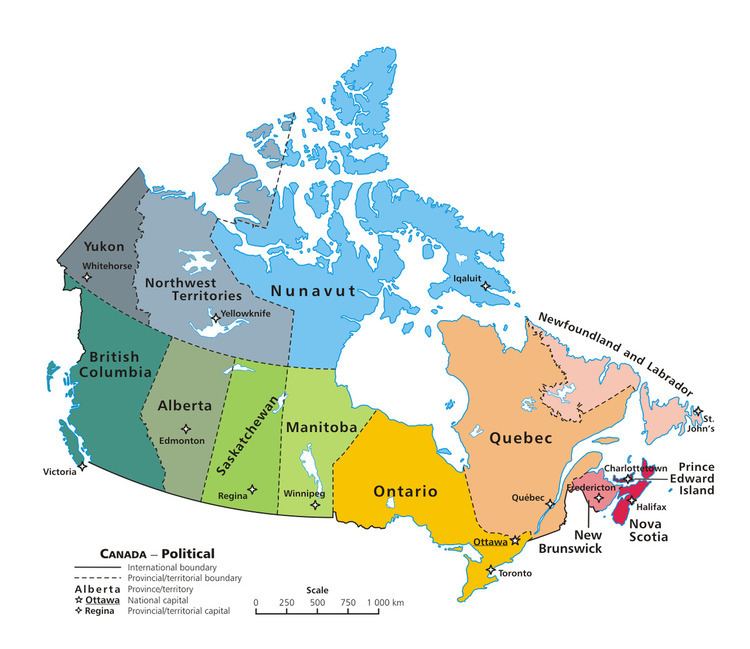 | ||
This is a list of incorporated cities in Canada, in alphabetical order categorized by province or territory. More thorough lists of communities are available for each province.
Contents
Alberta
To qualify as a city in Alberta, a sufficient population size (10,000 people or more) must be present and a majority of the buildings must be on parcels of land smaller than 7003185000000000000♠1,850 square metres. A community is not always incorporated as a city even if it meets these requirements. The urban service areas of Fort McMurray and Sherwood Park are hamlets recognized as equivalents of cities, but remain unincorporated. Nine towns are also eligible for city status but remain incorporated as towns.
Alberta has 18 cities. Chestermere is Alberta's newest city, incorporating from town status on January 1, 2015.
Notes:
British Columbia
In British Columbia, a community can be incorporated as a city if its population exceeds 5,000. Once so incorporated, a city does not lose this status even if its population later declines; the once-larger City of Greenwood, for example, now has a population of just 665 people. [1]
British Columbia has 50 cities.
Notes:
Manitoba
A community in Manitoba may seek city status once reaching a population of 7,500. Manitoba's newest city is Morden, which changed from town to city status on August 24, 2012.
Manitoba has 10 cities.
Notes:
New Brunswick
New Brunswick has eight cities.
Notes:
Newfoundland and Labrador
Newfoundland and Labrador has three cities.
Notes:
Northwest Territories
As in the other two Canadian territories, the only incorporated city in the Northwest Territories is its capital, Yellowknife.
Nova Scotia
Nova Scotia no longer has any incorporated cities, as they were amalgamated into regional municipalities in the 1990s.
Nunavut
As in the other two Canadian territories, the only incorporated city in Nunavut is its capital, Iqaluit.
Ontario
In Ontario, city status is conferred by the provincial government, generally upon the request of the incorporated municipality. A municipality may apply for city status anytime after its population surpasses 10,000. This status is not automatically conferred on a community that reaches this population target, but must be requested by the municipality and granted by the provincial Ministry of Municipal Affairs and Housing. Not all municipalities which reach this population target have pursued city designation. For example, Ajax, Oakville, Richmond Hill and Whitby, which all had populations greater than 100,000 in 2011, are still designated as towns. Once designated a city, however, a municipality does not lose this status even if its population later falls back below 10,000 (as, for example, Dryden). Ontario's newest city is Markham, which changed from town to city status on July 1, 2012.
Ontario has 51 cities.
Notes:
Prince Edward Island
Prince Edward Island has two cities.
Notes:
Quebec
In Quebec, provincial law does not currently distinguish between towns and cities — one designation, ville, covers both types of communities regardless of size. A ville might be informally referred to as a town or a city in English, but this is an arbitrary and subjective distinction. Quebec does, however, distinguish between villes and municipalités.
Quebec has 222 villes.
Notes:
Saskatchewan
In Saskatchewan, Section 39(1) of The Cities Act indicates a town must have a population of 5,000 or more and meet other criteria in order to incorporate as a city, although in the early 20th century several centres such as Saskatoon and Regina were granted city status despite having a smaller population. The City of Melville retains its city status despite dropping below 5,000 people in the 1990s. Kindersley has expressed an interest in applying for city status upon reaching the 5,000 milestone. Saskatchewan's newest city is Warman, which changed from town to city status on October 24, 2012.
Saskatchewan has 16 cities.
Notes:
Yukon
As in the other two Canadian territories, the only incorporated city in the Yukon is its capital, Whitehorse. Dawson was also previously incorporated as a city, but when the criteria were changed in the 1980s, its status was reduced to that of a town due to population. Through special provision, however, it is officially the town of the city of Dawson.
